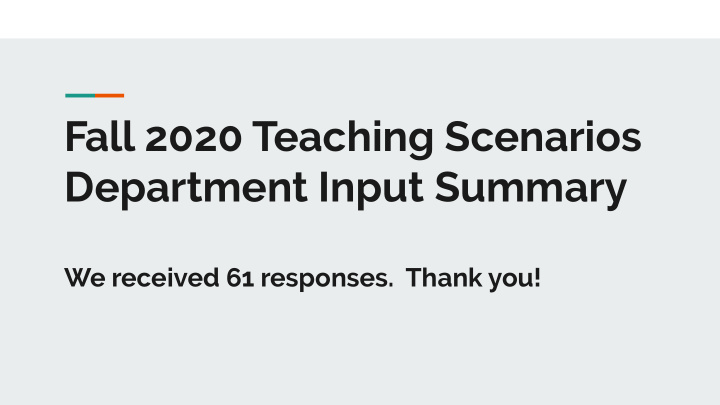



Fall 2020 Teaching Scenarios Department Input Summary We received 61 responses. Thank you!
Scenarios ● Scenario 1: Fully Remote ● Scenario 2: Hybrid ● Scenario 3: Socially Distant On-Campus ● Scenario 3.5: Half of the UGs each for Half of the Time ● Scenario 3.75: Three Semesters ● Ideas for moving from “managing” to “thriving”
Some key questions asked ● Please give us a sense of your plans if MIT is … ● What are the practical requirements / impediments for teaching this way... ● How can we help you? ● Which of your current learning objectives CANNOT be achieved remotely? ● How would you operate if there’s social distancing for labs, projects, etc. ● How might you suggest that MIT divide the students? ● What are specific learning opportunities that would be unique?
Preferred scenarios ● Scenarios 2 and 3 treated less as distinct and more as a continuum ● Fully remote generally regarded as doable but less than ideal ● The trimester option (3.75) was widely rejected ● The 50-50 option (3.5) was considered better than 3.75 by most, but… ○ Concerns about impacts on making students move out midway ○ Mixed ability to condense the hands-on portions ● Presuming most (but not all due to health risks and/or visa issues) students live on or near campus, departments have varying strategies for hybrid teaching. In general this seemed like the best option to most, given that it allows hands-on lab and project classes.
Shared values / philosophy ● Health and safety as first priority ● Equity and access are crucial ● Social interaction/community ● Ensuring departmental “culture” is maintained ● The residential learning experience is… ○ essential, if not inextricable to an MIT education ○ has as much (if not more) to do with interactions outside of the classroom as inside of it
Commonly mentioned strategies ● Thinking small (physically and in terms of offerings) ○ Smaller sections for lab classes ○ Reducing number of electives offered ● Rethinking teaching spaces ○ Smaller recitation-style rooms for lecture video capture and larger lecture spaces for socially distanced discussions ○ Use event spaces for class teaching ○ Teach outside or under tents
Commonly mentioned strategies ● Building partnerships ○ Create partnerships with peers / other relevant entities ● Mixed mode teaching ○ Record synchronous lectures that are accessed asynchronously ○ Offer different classes to remote and in-person students ○ Design the online version first and then adapt for in-person ○ Build peer relationships between in-person and remote students ○ Accommodate more independent studies
Rethinking Labs ● Record experiments in labs, students analyze data remotely ● Redesign project/lab class curricula to have the hands-on work concentrated in one half of the term (Scenario 3.5) ● Send kits (supplies, low-voltage electronics, etc.) to students ● Increased emphasis on coding and simulations ● Move lab classes to spring term (potentially cutting some content to account for increased use of labs)
Technology, Training, & Coordination ● Better video equipment & editing capabilities (strong interest) ● Video capture in classrooms (strong interest) ● A centralized system of virtual lounges / peer workspaces ● Faculty training for online tools and pedagogy ● Forum for cross-departmental coordination (particularly for overlapping requirements) ● Access to Bloomberg terminals (Sloan)
Policy & Procedural Needs/Wants ● Guidance for allowing group work on psets while socially distancing ● Different grading policies/expectations for remote students if some students are in-person and others are remote ● Procedures for finding remote RAships for incoming students or tuition support for these students ● Flexibility on class time restrictions to allow recitation times in different time zones and/or more lab times for in-person classes ● Offer UROPs to graduating seniors
Financial Needs/Wants ● Financial and visa support for international students ● Additional TA support to enable smaller recitations ● Funding for more staffed hours in labs and machine shops ● Funding to send necessary lab equipment to student homes ● Free out of state mental health treatment for remote students ● Funding for remote guest speakers
Some unique ideas / insights ● Anthropology … Students can pursue “real world” investigations of concepts or issues discussed in class readings and lectures. We can “bring the world” into the classroom by asking students to report from their home cities, states and countries.
Some unique ideas / insights ● ChemE … If students are not able to return to campus, it may be possible to use local MIT Clubs to help catalyze connections between students in remote locations.
Some unique ideas / insights ● D-Lab … offering “bite-size” virtual learning modules that could teach students maker skills or other skills at home. This would be a way of exposing more students to D-Lab’s work in an accessible and fun way...
Some unique ideas / insights ● Media Arts & Sciences … Create a special subjects MAS course focused on designing new models for blended and online learning - using COVID as the immediate challenge, but looking much further ahead to new ways of supporting collaboration, knowledge generation, and learning in a particularly ML/MAS style.
Good to remember Even just being away from family, challenging situations and environments, and having good wifi access, better accommodations and dining, and being “around classmates”, can make a HUGE difference for learning (esp. if remote).
What’s next ● We welcome further thoughts ● 2020 team members will study detailed inputs: https://drive.google.com/drive/folders/1kvGH7WksEsBp rkMIa2SzfF9XmmrOUiWv?usp=sharing ● Working to define small set of “leading contender” options for fall ● And a process for broader community engagement in evaluating these
Recommend
More recommend